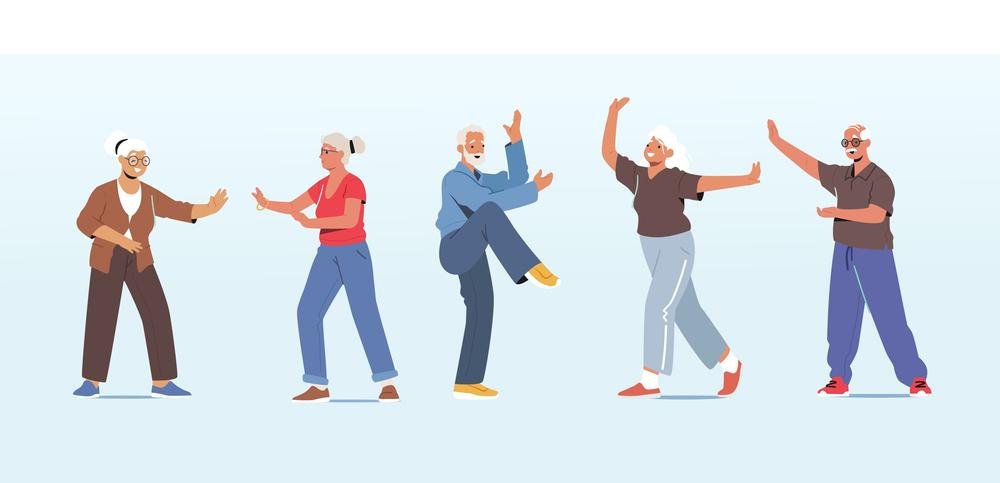Tai Chi is an ancient Chinese practice that combines slow, flowing movements with deep breathing and mindfulness. It’s e...
The Transformative Benefits of Tai Chi — Especially for Seniors, Hypertension, and Diabetes

The Transformative Benefits of Tai Chi — Especially for Seniors, Hypertension, and Diabetes
Tai Chi—often described as “meditation in motion”—combines slow, intentional movements with deep, mindful breathing. It’s a low-impact, accessible practice that delivers a host of physical and mental benefits, making it particularly effective for older adults and those managing high blood pressure or type 2 diabetes.
1. Enhances Balance & Prevents Falls in Older Adults
Falls are a major concern for older individuals, but regular practice of Tai Chi can significantly reduce this risk. Research shows a 43% reduction in fall risk during the first year, and sustained benefits beyond that period.(TIME) Tai Chi enhances flexibility, reaction time, and gait—building a more secure foundation in motion.(TIME)
2. Lowers Blood Pressure
Tai Chi has been shown to improve both systolic and diastolic blood pressure. A large review found it to be more effective than no treatment, health education, or even certain antihypertensive exercises and medications.(NCCIH) A recent high-quality meta-analysis confirmed that Tai Chi, among other mind-body exercises, led to significant reductions in blood pressure and even decreases in BMI and waist circumference—key cardiovascular risk factors.(BioMed Central) Notably, a year-long study found Tai Chi more effective at lowering blood pressure than intense aerobic workouts.(Business Insider, Reddit)
3. Helps Manage Type 2 Diabetes
For individuals with type 2 diabetes, Tai Chi offers improvements in:
- Fasting blood glucose and HbA1c levels(NCCIH, PubMed)
- Insulin resistance, BMI, and cholesterol levels(PubMed)
- Triglycerides, total cholesterol, and LDL cholesterol in diabetic patients(Wiley Online Library)
One meta-analysis of elderly patients found Tai Chi not only led to better blood glucose control (mean glucose reduced by ~12.5 mg/dL), but also improved balance confidence and standing stability—enhancing independence and quality of life.(SAGE Journals, PMC)
4. Amplifies Quality of Life, Cognitive Function & Emotional Health
Tai Chi’s slow, mindful movements also support mental and emotional well-being. Among older adults with cardiovascular conditions, it improves psychological well-being, mental health quality of life, and reduces symptoms of depression.(NCCIH) It enhances cognitive function and memory in older individuals with mild impairment.(Health) Additionally, its relaxing nature helps relieve stress, improve mood, and foster a sense of calm—benefits that are particularly meaningful for seniors.(Health, iHerb)
Summary Table
| Target Group | Major Benefits of Tai Chi |
|---|---|
| Older Adults | Falls prevention, improved balance, cognitive function, and emotional well-being. |
| High Blood Pressure | Meaningful reductions in both systolic and diastolic BP—even vs. aerobic exercise. |
| Type 2 Diabetes Patients | Better blood glucose control, lipid improvements, insulin resistance reduction, quality of life. |
| All Groups (Holistic Wellness) | Stress reduction, better mood, and improved overall quality of life. |

For mellow movement that helps your heart, try tai chi
Need a workout that's engaging but won't leave you feeling tired and sweaty? Tai chi may be just the ticket.
Most people recognize that exercise is one of the best ways to boost cardiovascular health. But what if traditional exercise seems either too challenging or otherwise inaccessible — or maybe even boring? Or perhaps you're recovering from a heart attack or other medical problem and need to ease back into activity. If so, tai chi might be worth a try.
"Tai chi is a gentle, adaptable practice that features flowing movements combined with breathing and cognitive focus," says Dr. Peter Wayne, associate professor of medicine at Harvard Medical School and medical editor of the Harvard Special Health Report An Introduction to Tai Chi (/TC). The cardiovascular benefits likely stem from a combination of the physical and mental aspects of this ancient Chinese practice.
Body and mind benefits
A tai chi session doesn't aim to dramatically raise your heart rate or build bulky muscles. But the slow, deliberate movements still help to tone your muscles. If you move more quickly from one position to the next and sink deeper into the postures, tai chi can even provide a moderate aerobic workout.
Conversely, you can dial down the intensity and even do certain movements while seated in a chair. Unlike yoga, tai chi doesn't require you to fully extend or stretch your joints, so it's fine for people who are not so flexible.
Like yoga, tai chi is a mind-body practice that requires focused attention as you move through a series of choreographed moves. Many have descriptive names that evoke scenes from nature, such as "wave hands like clouds" or "the white crane spreads its wings." Concentrating on that imagery, along with your breathing and movements, counteracts what Asian meditative traditions call "monkey mind" — the distracting mental chatter that often intrudes when people do traditional meditation. In this way, tai chi can foster relaxation and ease stress. Tai chi also teaches you to pay close attention to your posture, breathing, and heart rate. "This increased body awareness can help prevent injury and overexertion," says Dr. Wayne.
Heartfelt effects
An article published online July 3, 2023, by Cardiology in Review considered the heart-related benefits of tai chi. Many studies have documented improvements in blood pressure after just eight to 12 weeks of practicing tai chi, including among older, sedentary adults and heart attack survivors. There's also good evidence that tai chi can be an effective alternative for people who don't want to do traditional cardiac rehabilitation (a structured program of exercise and education for people recovering from heart-related problems). In addition, tai chi has proved helpful for people with heart failure, who tend to be tired and weak as a result of the heart's diminished pumping ability.
The authors also point out that tai chi can be a gateway to other types of physical activity because the practice may improve balance, reduce the risk of falls, and even help ease lower back pain — a common reason for avoiding exercise. "More fundamentally, the fitness gains and self-awareness from tai chi training can give people the confidence to engage in other physical and social activities that can enhance health," says Dr. Wayne.
Ready to try tai chi?
Tai chi classes are often offered at martial arts studios, but you can also find them at senior or community centers, health clubs, universities, or hospitals. Most facilities list class descriptions on their websites; if not, call to inquire which class would be best for you, based on your experience and fitness level.
Many of the academic health centers throughout the United States with integrative health programs offer tai chi classes. Some cardiac rehabilitation programs, including those affiliated with several Harvard teaching hospitals, incorporate tai chi into their programs.
Hourlong classes usually cost around $15 to $25. Some centers allow you to pay by the week, month, or several months. Many places now offer online classes as well, and evidence shows that you can reap similar benefits from virtual instruction.
Wear loose, comfortable clothing and supportive shoes like sneakers (or no shoes, if you prefer). During the class, the instructor will demonstrate graceful, slow arm and leg movements, often done with a slight bend in the knees. The sequence of poses can be done standing or, in some cases, while seated in a chair.
You can also watch and follow along with the free videos that illustrate movements from the Harvard report on tai chi at /tai-chi-calisthenics and /tai-chi-elements.

Share:




